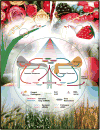Cross-kingdom RNA trafficking and environmental RNAi for powerful innovative pre- and post-harvest plant protection
- PMID: 28570950
- PMCID: PMC5720367
- DOI: 10.1016/j.pbi.2017.05.003
Cross-kingdom RNA trafficking and environmental RNAi for powerful innovative pre- and post-harvest plant protection
Abstract
Small RNA (sRNA) induces RNA interference (RNAi) in almost all eukaryotes. While sRNAs can move within an organism, they can also move between interacting organisms to induce gene silencing, a phenomenon called 'cross-kingdom RNAi'. Some sRNAs from pathogens or pests move into host cells and suppress host immunity in both plants and animals; whereas some host sRNAs travel into pathogen/pest cells to inhibit their virulence. Moreover, uptake of exogenous RNAs from the environment was recently discovered in certain fungal pathogens, which makes it possible to suppress fungal diseases by directly applying pathogen-targeting RNAs on crops and post-harvest products. This new-generation of RNA-based fungicides is powerful, environmentally friendly, and can be easily adapted to control multiple diseases simultaneously.
Copyright © 2017 Elsevier Ltd. All rights reserved.
Figures

References
-
- Oerke EC. Crop losses to pests. J Agr Sci. 2006;144:31–43.
-
- Sharma RR, Singh D, Singh R. Biological control of postharvest diseases of fruits and vegetables by microbial antagonists: A review. Biol Control. 2009;50:205–221.
-
- Kader AA. Increasing food availability by reducing postharvest losses of fresh produce. Proceedings of the 5th International Postharvest Symposium. 2005;1-3:2169–2175.
-
- Baulcombe D. RNA silencing in plants. Nature. 2004;431:356–363. - PubMed
-
- Kim VN, Han J, Siomi MC. Biogenesis of small RNAs in animals. Nat Rev Mol Cell Biol. 2009;10:126–139. - PubMed
Publication types
MeSH terms
Substances
Grants and funding
LinkOut - more resources
Full Text Sources
Other Literature Sources

